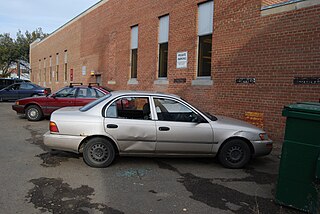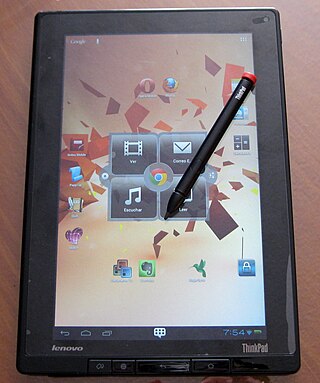
Motor vehicle theft or car theft is the criminal act of stealing or attempting to steal a motor vehicle.

The International Mobile Equipment Identity (IMEI) is a numeric identifier, usually unique, for 3GPP and iDEN mobile phones, as well as some satellite phones. It is usually found printed inside the battery compartment of the phone but can also be displayed on-screen on most phones by entering the MMI Supplementary Service code *#06# on the dialpad, or alongside other system information in the settings menu on smartphone operating systems.

Art theft, sometimes called artnapping, is the stealing of paintings, sculptures, or other forms of visual art from galleries, museums or other public and private locations. Stolen art is often resold or used by criminals as collateral to secure loans. Only a small percentage of stolen art is recovered—an estimated 10%. Many nations operate police squads to investigate art theft and illegal trade in stolen art and antiquities.
Laptop theft is a significant threat to users of laptop computers. Many methods to protect the data and to prevent theft have been developed, including alarms, laptop locks, and visual deterrents such as stickers or labels. Victims of laptop theft can lose hardware, software, and essential data that has not been backed up. Thieves also may have access to sensitive data and personal information. Some systems authorize access based on credentials stored on the laptop including MAC addresses, web cookies, cryptographic keys and stored passwords.
Anti-theft systems protect valuables such as vehicles and personal property like wallets, phones, and jewelry. They are also used in retail settings to protect merchandise in the form of security tags and labels. Anti-theft systems include devices such as locks and keys, RFID tags, and GPS locators.
LoJack is a stolen vehicle recovery and IoT connected car system that utilizes GPS and cellular technology to locate users' vehicles, view trip history, see battery levels, track speeding, and maintain vehicle health via a native app. Prior to selling a vehicle, LoJack dealers can use the system to manage and locate inventory, view and manage battery health, and recover stolen inventory.
Data erasure is a software-based method of data sanitization that aims to completely destroy all electronic data residing on a hard disk drive or other digital media by overwriting data onto all sectors of the device in an irreversible process. By overwriting the data on the storage device, the data is rendered irrecoverable.
Baby Jesus theft is the theft of figurines of the infant Jesus from outdoor public and private nativity displays during the Christmas season. It is an "enduring practice" according to New York Times journalist Katie Rogers, "believed to be part of a yearly tradition, often carried out by bored teenagers looking for an easy prank." Sometimes these are stolen for resale, other times the associated pranks are more involved and include dropping it off somewhere else.
HEAT LANrev is systems lifecycle management software used by system administrators to automate IT administration tasks. The product includes server and client ("agent") software that runs on Windows and macOS.

Prey is a software and online platform for mobile device tracking, management, and protection available for laptops, tablets, and mobiles. The software and service is developed by the Chilean company Prey Inc., successor of the funding company Fork Ltd.
A vehicle tracking system combines the use of automatic vehicle location in individual vehicles with software that collects these fleet data for a comprehensive picture of vehicle locations. Modern vehicle tracking systems commonly use GPS or GLONASS technology for locating the vehicle, but other types of automatic vehicle location technology can also be used. Vehicle information can be viewed on electronic maps via the Internet or specialized software. Urban public transit authorities are an increasingly common user of vehicle tracking systems, particularly in large cities.
Book store shoplifting is a problem for book sellers and has sometimes led stores to keep certain volumes behind store counters.

Robbins v. Lower Merion School District is a federal class action lawsuit, brought in February 2010 on behalf of students of two high schools in Lower Merion Township, a suburb of Philadelphia. In October 2010, the school district agreed to pay $610,000 to settle the Robbins and parallel Hasan lawsuits against it.
Find my Phone or similar is the name given by various manufacturers to software and a service for smartphones, whereby a registered user can find the approximate location of the phone if switched on, over the Internet, or by the phone sending e-mail or SMS text messages. This helps to locate lost or stolen phones.
A mobile application or app is a computer program or software application designed to run on a mobile device such as a phone, tablet, or watch. Mobile applications often stand in contrast to desktop applications which are designed to run on desktop computers, and web applications which run in mobile web browsers rather than directly on the mobile device.

The ThinkPad Tablet is a tablet computer made by Lenovo as part of its series of Android-based tablet devices and is targeted towards business users. Lenovo's tablet offerings are available in both ThinkPad and IdeaPad variants. While the ThinkPad Tablets are designed for business, the IdeaPad tablets, like the laptops of the same name, are meant for home and personal use. These tablets are different from Lenovo's X Series tablets, which are laptop/tablet hybrids and which use Microsoft Windows as their operating system.
Absolute Home & Office is a proprietary laptop theft recovery software. The persistent security features are built into the firmware of devices. Absolute Home & Office has services of an investigations and recovery team who partners with law enforcement agencies to return laptops to their owners. Absolute Software licensed the name LoJack from the vehicle recovery service LoJack in 2005.
The following outline is provided as an overview of and topical guide to computer security:

BrickHouse Security is a New York City-based security company that sells security systems, including video cameras and hidden cameras, and GPS trackers to law enforcement agencies, businesses and individuals. The company is the parent company of GPS tracking device companies Securus and Zoombak.
A security switch is a hardware device designed to protect computers, laptops, smartphones and similar devices from unauthorized access or operation, distinct from a virtual security switch which offers software protection. Security switches should be operated by an authorized user only; for this reason, it should be isolated from other devices, in order to prevent unauthorized access, and it should not be possible to bypass it, in order to prevent malicious manipulation.







